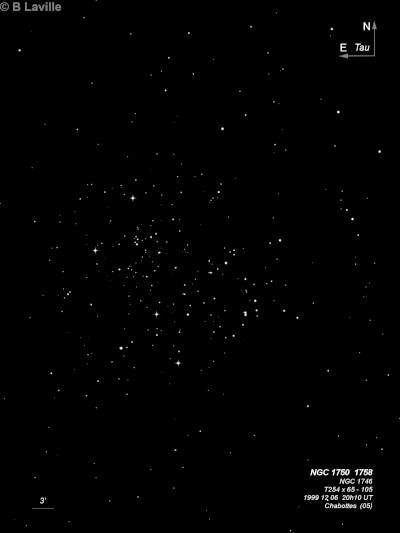
Heinrich d'Arrest discovered NGC 1746 on 9 Nov 1863 with an 11" refractor while searching for NGC 1750 and called it a poor cluster. His position was roughly 10' north of William Herschel's position for NGC 1750 = H. VIII-43 though d'Arrest refers to his "cluster" as H VIII-43. NGC 1746 is often applied to the entire 40' field including NGC 1750 and 1758 on the east side but Harold Corwin suggests that NGC 1746 may indeed be a duplicate of NGC 1750 or perhaps just a group of stars on the north edge of NGC 1750. In any case, it is not a separate cluster from NGC 1750 and 1759, although I've retained the position and size often found in observing books and atlases.
300/350mm - 13.1" (12/22/84): about 100 stars in 20' field. The brightest mag 7 star (HD 32461) at the south edge and there are many nearby bright stars.
400/500mm - 17.5" (2/22/87): very bright, very large, large range of magnitudes, spread out overall but locally rich in a few spots. Includes two main subgroups - NGC 1750 and NGC 1758 - which are probably the only clusters here, along with several mag 7.5-8.5 stars. NGC 1750 consists of two dozen stars on the south side. It appears as a fairly large oval oriented NW-SE with a void in the center and includes a nice mag 9.1/9.1 pair at 20". NGC 1758 is a richer, roundish group of stars close northeast (though probably unrelated physically to NGC 1950) including about two dozen stars. NGC 1758 is bracketed by two mag 8 stars oriented N-S and a mag 7 star is off the east end. Includes five mag 13 stars at the east side.
NGC 1746, although often applied to the 40' field including NGC 1750 and 1758, may in fact be a duplicate of NGC 1750 or just a group of faint field stars noted by d'Arrest while searching for NGC 1750.
Notes by Steve Gottlieb